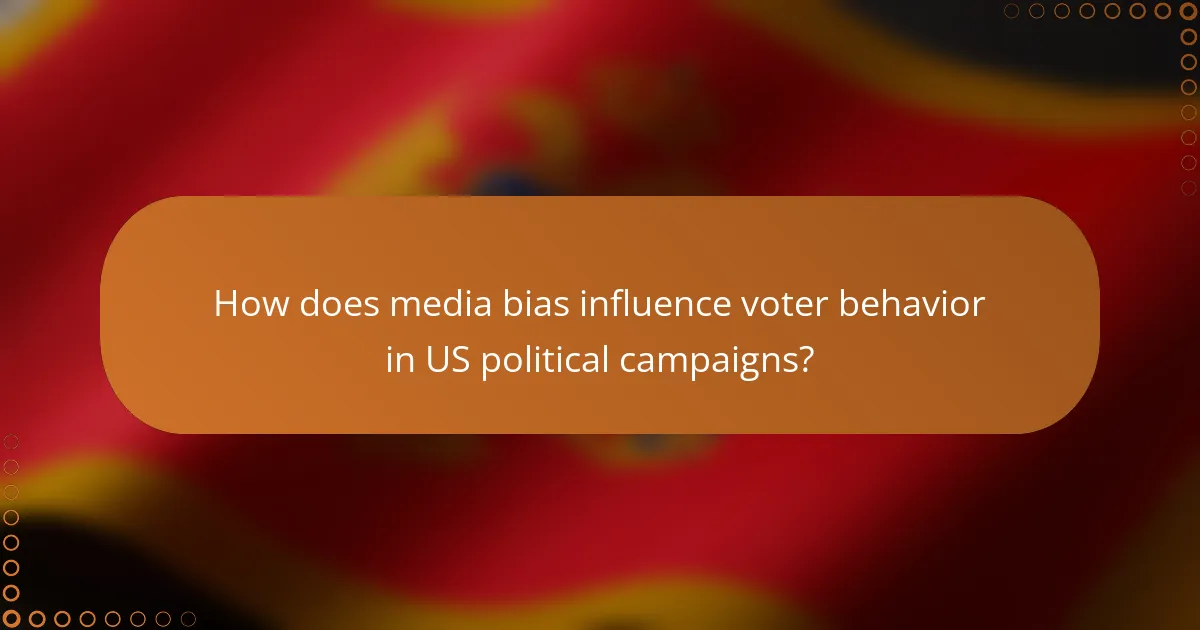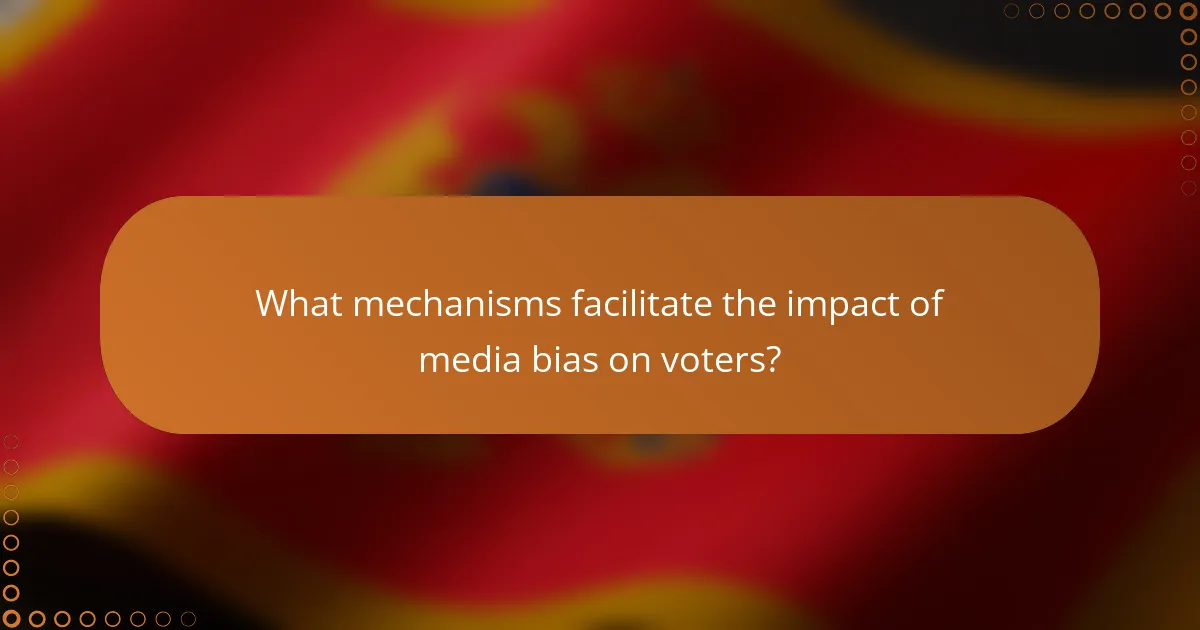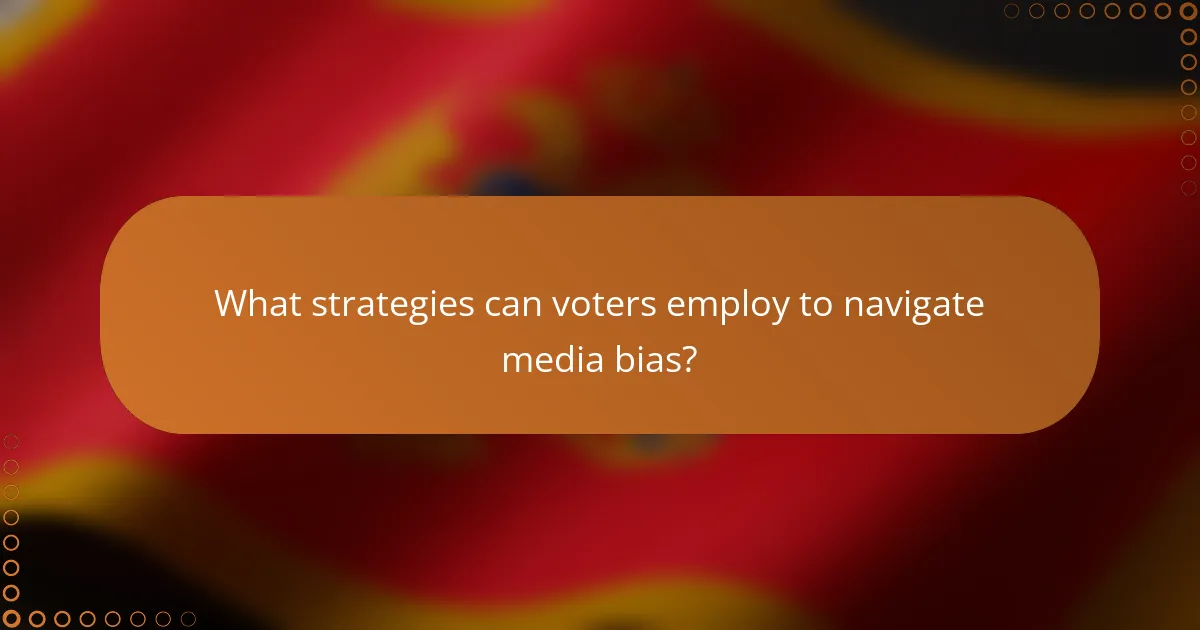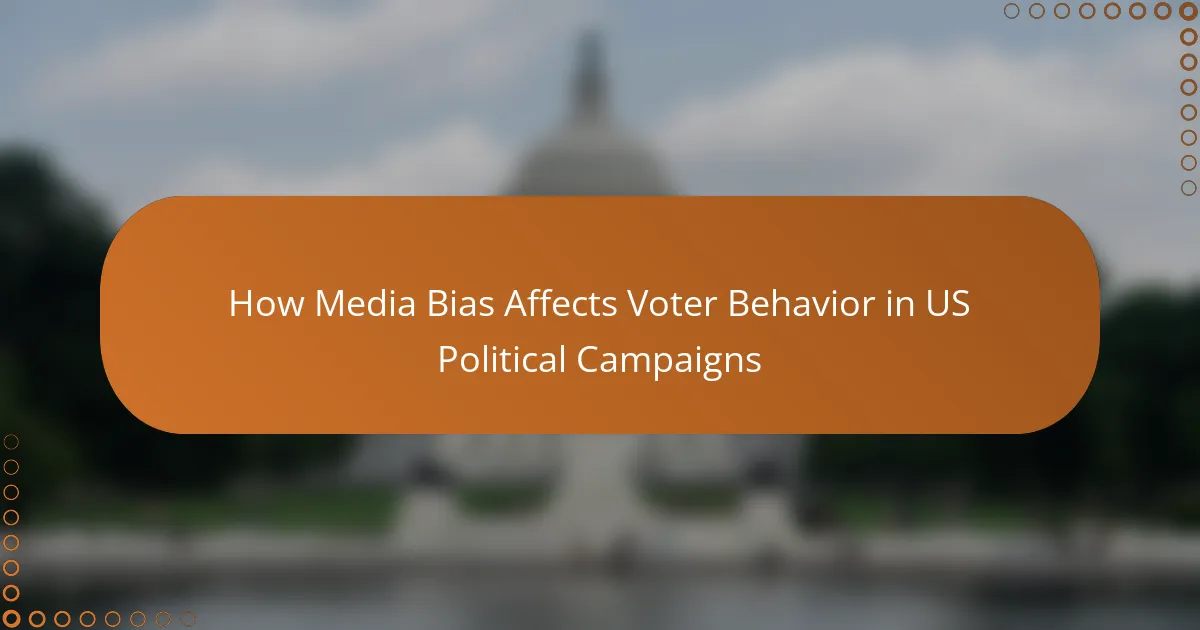Media bias is a significant factor influencing voter behavior in US political campaigns. It shapes public perception of candidates and issues through mechanisms such as selective exposure, framing, and agenda-setting. Research indicates that biased reporting can reinforce existing beliefs, leading to stronger partisan identities and impacting voting decisions. Voters can navigate media bias by diversifying their news sources, critically evaluating credibility, seeking independent outlets, and engaging with diverse viewpoints. Understanding these dynamics is essential for recognizing how media bias affects electoral outcomes.

How does media bias influence voter behavior in US political campaigns?
Media bias significantly influences voter behavior in US political campaigns. Biased reporting can shape public perception of candidates and issues. For instance, studies indicate that voters are more likely to trust information that aligns with their existing beliefs. This phenomenon is known as confirmation bias. Research by the Pew Research Center shows that partisan media can reinforce polarization among voters. Voters exposed to biased coverage often develop stronger partisan identities. This, in turn, affects their voting decisions. In the 2016 election, for example, media coverage favored certain candidates, impacting voter turnout and preferences. Overall, media bias plays a crucial role in shaping electoral outcomes.
What are the different types of media bias present in political reporting?
There are several types of media bias present in political reporting. These include bias by omission, where important information is left out. Bias by selection occurs when certain stories are highlighted while others are ignored. Bias by placement refers to the positioning of stories in a way that affects their perceived importance. Bias by labeling involves the use of loaded language to describe individuals or groups. Additionally, ideological bias reflects the media outlet’s political leanings, impacting coverage. Confirmation bias occurs when media reinforces existing beliefs rather than presenting balanced viewpoints. Each type of bias can significantly influence voter perception and behavior during campaigns.
How do these types of media bias manifest in news coverage?
Media bias manifests in news coverage through selective reporting, framing, and language choice. Selective reporting occurs when certain facts are emphasized while others are downplayed or ignored. This can skew public perception of events or issues. Framing involves presenting information in a way that influences interpretation. For example, describing a protest as a “riot” versus a “demonstration” can alter audience perception. Language choice also plays a critical role; positive or negative connotations can shape opinions about a subject. Research indicates that biased language can significantly impact voter attitudes and decisions. Studies show that media portrayal can lead to polarized views among audiences, affecting their voting behavior in political campaigns.
What examples illustrate the impact of these biases on public perception?
Media bias significantly shapes public perception in various ways. One example is the portrayal of political candidates during elections. For instance, studies show that candidates receiving favorable coverage tend to have higher approval ratings. In the 2016 U.S. presidential election, Donald Trump received extensive coverage, which influenced voter perceptions of his viability as a candidate.
Another example is the framing of issues like immigration. Media outlets that emphasize negative aspects often lead to public fear and support for stricter policies. Research from the Pew Research Center indicates that biased reporting can shift public opinion on immigration policies significantly over time.
Additionally, the representation of demographic groups can skew public perception. Coverage that highlights negative stereotypes can lead to increased prejudice against those groups. The portrayal of African Americans in crime-related news has been linked to heightened public fear and support for punitive policies.
These examples illustrate how media bias directly affects voter behavior and public perception in political contexts.
Why is understanding media bias important for voters?
Understanding media bias is crucial for voters because it influences their perception of political information. Media bias can shape narratives and highlight specific issues while downplaying others. This selective reporting affects how voters interpret candidates and policies. Research indicates that biased media can sway public opinion and voting behavior. For instance, a study by the Pew Research Center found that individuals exposed to biased news sources were more likely to favor candidates aligned with those sources. Therefore, recognizing media bias empowers voters to critically evaluate information and make informed decisions.
How does media bias shape voter opinions and decisions?
Media bias significantly shapes voter opinions and decisions by influencing perceptions of candidates and issues. Biased reporting can highlight specific narratives while downplaying others. This selective coverage affects how voters interpret facts and form opinions. For instance, studies show that voters exposed to biased media are more likely to align with the viewpoints presented. A 2016 study by the Pew Research Center found that 62% of Americans felt that news organizations favor one side when reporting. Additionally, media framing can lead to emotional responses that sway voter behavior. In the 2020 election, biased coverage contributed to polarization among voters, impacting their decision-making processes.
What role does media literacy play in mitigating the effects of bias?
Media literacy plays a crucial role in mitigating the effects of bias. It equips individuals with the skills to critically analyze media content. This analysis helps identify biased language and framing in news sources. Research shows that media literacy education can reduce susceptibility to misinformation. A study by the Stanford History Education Group found that students with media literacy training were better at discerning credible sources. By fostering critical thinking, media literacy empowers voters to make informed decisions. It ultimately promotes a more balanced understanding of political narratives. This understanding is essential in navigating the complexities of US political campaigns.

What mechanisms facilitate the impact of media bias on voters?
Media bias impacts voters through mechanisms such as selective exposure, framing, and agenda-setting. Selective exposure occurs when voters choose media sources that align with their pre-existing beliefs. This reinforces their views and limits exposure to opposing perspectives. Framing involves presenting information in a way that influences interpretation. For example, a news story can highlight certain aspects while downplaying others, shaping voter perceptions. Agenda-setting refers to the media’s ability to prioritize issues, influencing what voters consider important. Research shows that these mechanisms can significantly sway voter opinions and behaviors, as demonstrated in studies like “The Effects of Media Bias on Political Attitudes” by DellaVigna and Kaplan.
How do social media platforms contribute to media bias?
Social media platforms contribute to media bias by amplifying selective information and creating echo chambers. These platforms use algorithms that prioritize content based on user engagement. This leads to the promotion of sensational or partisan content over balanced reporting. Research shows that users are more likely to engage with posts that align with their existing beliefs. This behavior reinforces biases and limits exposure to diverse viewpoints. A study by the Pew Research Center found that 62% of Americans get news from social media, which often skews their perception of reality. Consequently, social media can significantly shape public opinion and voter behavior by highlighting specific narratives while marginalizing others.
What algorithms influence the dissemination of biased information?
Algorithms that influence the dissemination of biased information include recommendation algorithms and social media algorithms. Recommendation algorithms prioritize content based on user engagement metrics. These metrics often favor sensational or polarizing information, leading to biased content being amplified. Social media algorithms curate users’ news feeds based on their interactions. This creates echo chambers, reinforcing existing beliefs and biases. Research shows that algorithms can lead to the spread of misinformation. A study by Vosoughi et al. (2018) found that false news spreads more rapidly than true news on social media platforms. This demonstrates the significant role algorithms play in shaping information dissemination.
How does user engagement affect the spread of media bias?
User engagement significantly amplifies the spread of media bias. Higher engagement, such as shares and comments, increases visibility of biased content. This visibility leads to wider dissemination across social networks. Algorithms prioritize engaging content, often favoring sensational or biased information. Studies show that emotionally charged articles receive more shares, perpetuating bias. For instance, a 2018 study by Vosoughi, Roy, and Aral found that false news spreads more rapidly than true news on social media. Thus, user engagement directly influences the reach and impact of media bias in political contexts.
What psychological factors make voters susceptible to media bias?
Voters are susceptible to media bias due to several psychological factors. Confirmation bias leads individuals to favor information that aligns with their preexisting beliefs. Cognitive dissonance occurs when voters experience discomfort from conflicting information, prompting them to dismiss opposing viewpoints. Social identity theory suggests that individuals align their beliefs with those of their social groups, making them more receptive to biased media that reinforces group norms. Additionally, the availability heuristic causes voters to rely on immediate examples or narratives presented by media, which can distort their perception of reality. Research indicates that emotionally charged content is more likely to be shared and remembered, further entrenching biased views. These psychological mechanisms collectively influence how voters interpret media messages and shape their political opinions.
How do cognitive biases affect voter interpretation of media content?
Cognitive biases significantly influence how voters interpret media content. These biases shape perceptions and decision-making processes. Confirmation bias leads voters to favor information that supports their preexisting beliefs. This results in selective exposure to media sources that align with their views. Anchoring bias causes voters to rely heavily on the first piece of information they encounter. This initial information can skew their understanding of subsequent content. The framing effect alters voters’ interpretations based on how information is presented. For instance, positive or negative framing can change the perceived importance of an issue. Studies show that these biases can lead to polarized opinions and misinformed voting decisions. Research by Nyhan and Reifler (2010) highlights how cognitive biases can distort factual understanding, impacting electoral outcomes.
What emotional responses do biased reports evoke in voters?
Biased reports evoke strong emotional responses in voters, including anger, fear, and mistrust. Anger arises when voters perceive manipulation or unfairness in reporting. Fear can be triggered by sensationalized information that portrays dire consequences. Mistrust develops as voters question the credibility of sources that present biased narratives. Research indicates that emotionally charged content significantly influences voter behavior and decision-making. For example, a study by the Pew Research Center found that exposure to biased media can increase polarization among voters, leading to heightened emotional reactions. These emotional responses ultimately affect voter engagement and electoral outcomes.

What strategies can voters employ to navigate media bias?
Voters can employ several strategies to navigate media bias. First, they should diversify their news sources. Consuming information from various outlets helps provide a more balanced perspective. Second, voters should critically evaluate the credibility of sources. Fact-checking organizations can help verify claims made in the media. Third, they can seek out independent and non-partisan news organizations. These sources often present information with less bias. Fourth, voters should be aware of their own biases. Self-awareness can help them recognize how personal beliefs influence their interpretation of news. Fifth, engaging in discussions with individuals holding different viewpoints can broaden understanding. This approach encourages critical thinking and challenges preconceived notions. Lastly, voters can utilize media literacy resources. Educational programs can enhance skills in identifying bias and misinformation.
How can voters identify and critically evaluate biased media sources?
Voters can identify and critically evaluate biased media sources by examining the source’s ownership and funding. Research indicates that media outlets funded by specific political interests often exhibit bias. Voters should analyze the language used in articles for loaded or emotionally charged terms. Studies show that such language can indicate a slant in reporting. Checking the diversity of viewpoints presented in a source is essential. Sources that only provide one perspective may not offer a balanced view. Voters can also look for fact-checking features or independent reviews of the media outlet’s accuracy. According to the Pew Research Center, media literacy is crucial for discerning bias. Engaging with multiple sources can provide a more comprehensive understanding of issues. This approach allows voters to make informed decisions based on a range of perspectives.
What tools and resources are available for assessing media reliability?
Fact-checking websites are essential tools for assessing media reliability. Websites like Snopes, FactCheck.org, and PolitiFact evaluate the accuracy of news stories and claims. These platforms provide evidence-based assessments that help users discern factual information from misinformation. Additionally, media bias charts, such as the Ad Fontes Media chart, categorize news outlets based on their political bias and reliability. Academic resources, like the Pew Research Center, offer studies on media consumption and bias effects. Other tools include browser extensions like NewsGuard, which rate the credibility of news sources. These resources collectively empower individuals to critically evaluate the media they consume.
How can voters diversify their media consumption to reduce bias?
Voters can diversify their media consumption by seeking out different news sources. This includes reading articles from various political perspectives. Engaging with international news outlets can provide a broader context. Additionally, voters should follow independent journalists and fact-checking organizations. Consuming media in different formats, such as podcasts and documentaries, can also help. Research indicates that exposure to diverse viewpoints reduces confirmation bias. A study by the Pew Research Center found that people who engage with multiple news sources are more informed. This approach encourages critical thinking and helps voters form well-rounded opinions.
What best practices can help voters make informed decisions during campaigns?
Voters can make informed decisions during campaigns by researching candidates and their positions. This includes reading official campaign materials and independent analyses. Voters should also verify facts using reputable sources. Engaging in discussions with diverse groups enhances understanding of different viewpoints. Attending town hall meetings allows voters to ask questions directly. Analyzing media coverage critically helps identify potential biases. Utilizing non-partisan voter guides can clarify candidate stances. According to the Pew Research Center, informed voters are more likely to participate in elections.
How can voters engage in discussions about media bias with others?
Voters can engage in discussions about media bias by sharing specific examples of biased reporting. They should reference particular articles or news segments that demonstrate bias. This helps ground the conversation in concrete evidence. Voters can also encourage others to analyze the language used in media coverage. Identifying loaded terms can reveal underlying biases. Engaging in discussions about the sources of news can also be effective. Voters should compare different outlets to highlight contrasting narratives. Additionally, they can ask questions that prompt critical thinking about media consumption. This approach fosters a deeper understanding of bias among participants.
What actions can voters take to promote unbiased reporting in media?
Voters can promote unbiased reporting in media by actively supporting independent and diverse news outlets. They should seek out sources that adhere to journalistic standards and fact-checking practices. Engaging in media literacy education is crucial. Voters can learn to identify bias and misinformation. They should also advocate for transparency in media ownership and funding. Supporting policies that protect journalistic integrity is important. Additionally, voters can participate in public discussions about media accountability. By demanding fairness, they can influence media practices and standards. These actions contribute to a more informed electorate and a healthier democracy.
The main entity of this article is media bias and its impact on voter behavior in US political campaigns. The article examines how various types of media bias, including bias by omission, selection, and framing, influence public perception of candidates and issues. It highlights the psychological factors that make voters susceptible to biased reporting, such as confirmation bias and cognitive dissonance. Additionally, the article discusses the role of social media in amplifying bias and offers strategies for voters to critically evaluate media sources and make informed decisions during elections. Understanding these dynamics is essential for navigating the complexities of political information in the media landscape.
